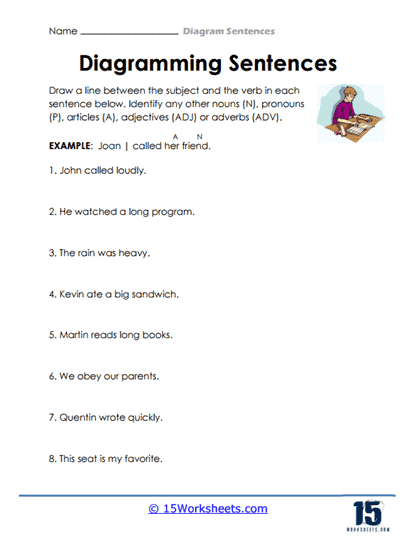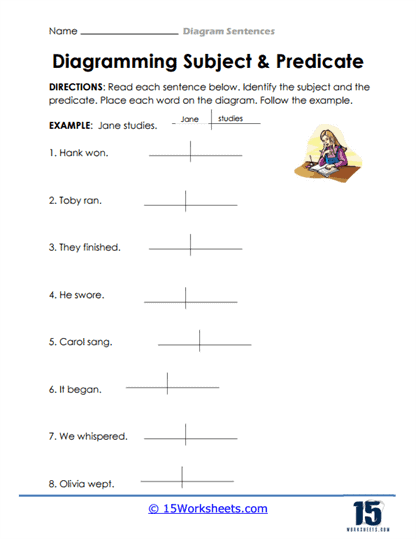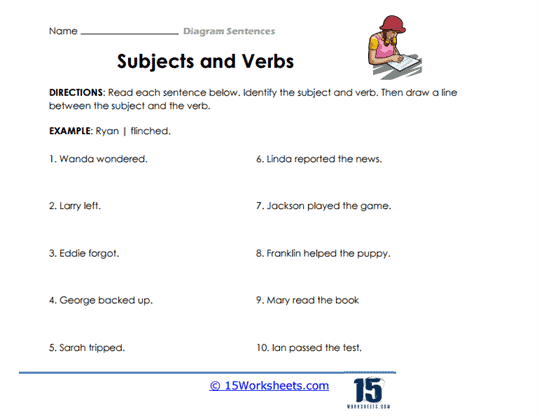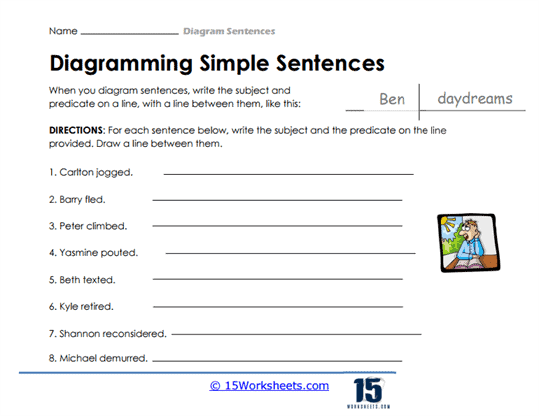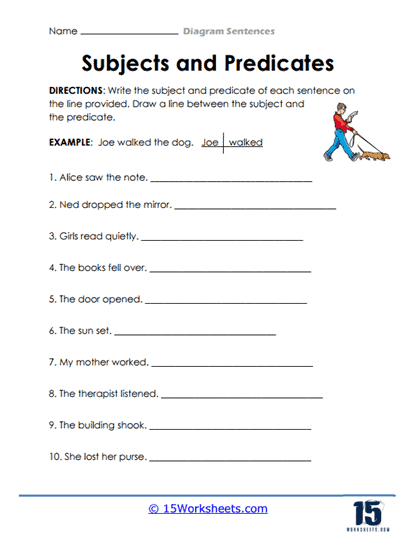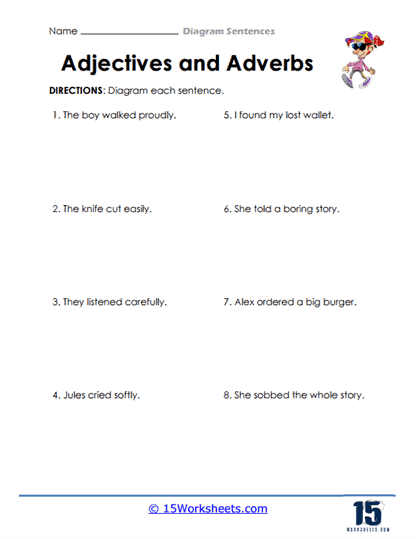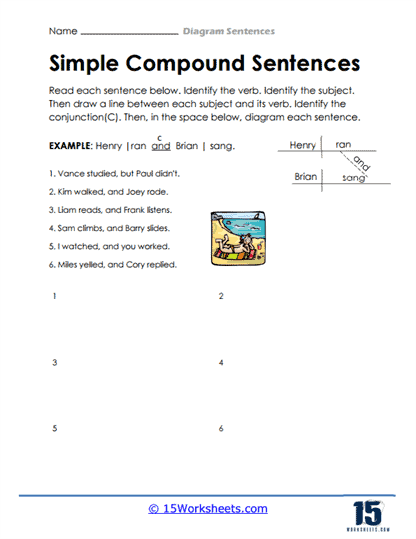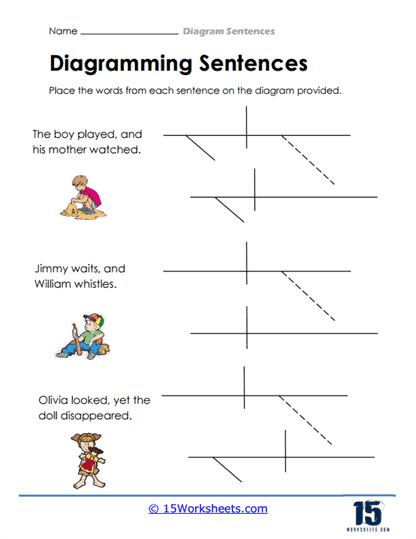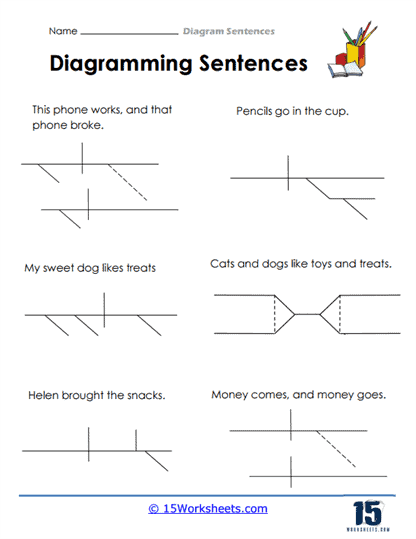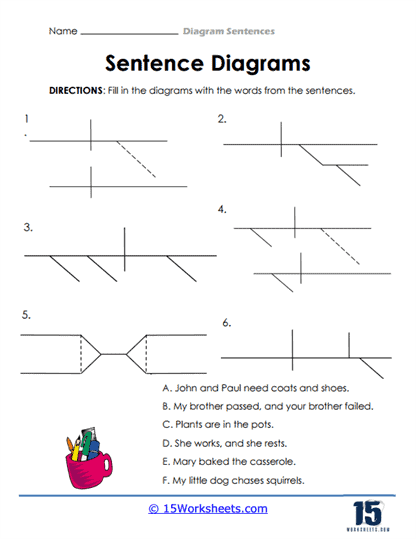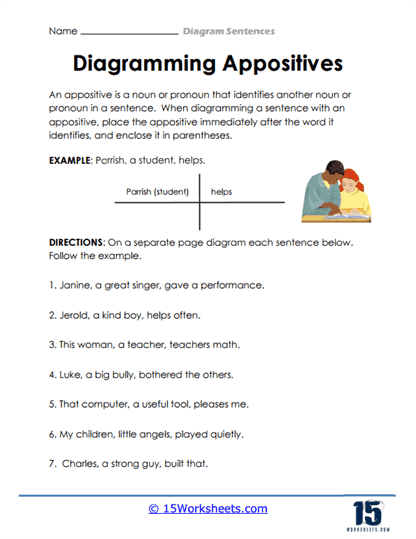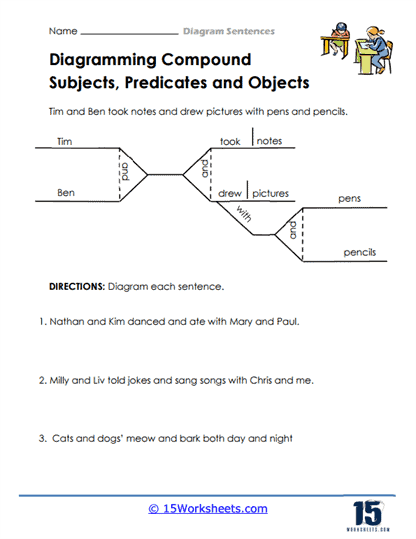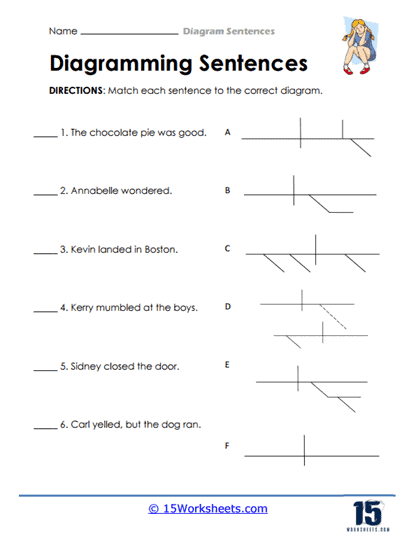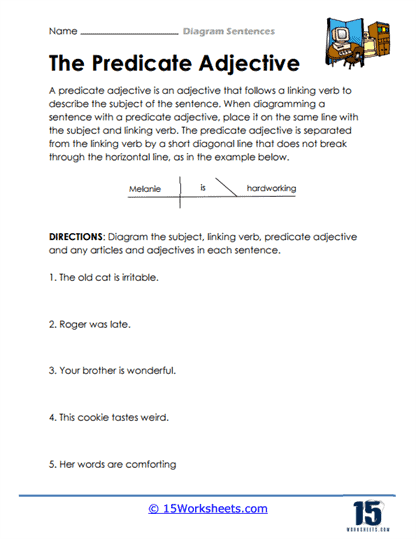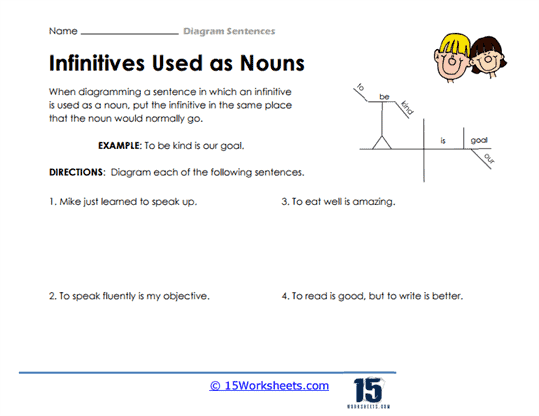Diagramming Sentences Worksheets
All About These 15 Worksheets
This collection of sentence diagramming worksheets focuses on various elements of sentence structure, aiming to develop students’ grammatical understanding and their ability to visually break down sentences. The worksheets encourage students to identify core grammatical components-subjects, predicates, and modifiers-while also introducing more complex sentence elements, such as compound subjects and predicates, appositives, and infinitives used as nouns. Together, these activities build essential literacy and syntactic skills.
The foundational exercises help students recognize and distinguish between subjects and verbs, teaching them how to locate and diagram these parts of speech. As students gain confidence, the worksheets increase in complexity, challenging them to recognize and diagram other sentence elements such as adjectives, adverbs, conjunctions, and pronouns. Through this progression, students not only practice identifying words in a sentence but also understand their function and how they relate to each other.
Several of the worksheets focus on expanding student knowledge of sentence construction by including exercises with compound subjects and predicates, as well as sentences with direct objects, articles, and adjectives. This encourages learners to understand how different sentence elements interact to form more complex meanings. The worksheets also incorporate more advanced sentence types, such as those with appositive phrases, allowing students to recognize nouns and pronouns that rename other nouns.
The collection also introduces exercises on predicate adjectives and infinitives used as nouns, providing students with a broader understanding of how verbs can function in different ways depending on the sentence structure. Through diagramming, students learn to visualize the relationships between these elements and how to properly structure complex sentences.
A Look At The Individual Worksheets
Diagramming sentences is like giving grammar a GPS-every word gets a little map dot, and these worksheets are the travel agents. Let’s start with the basics: Parts of Speech, Subject And Predicate, and Draw A Line are your sentence-structure training wheels. These worksheets give students a sturdy foundation, like teaching someone to sort their laundry before they’re allowed near a washing machine. “What’s the subject?” “Where’s the predicate?” “Why are you crying?” All these important questions are answered here. Draw A Line might sound like a toddler’s art class, but it’s sneakily philosophical-it forces kids to draw literal and metaphorical lines between sentence parts, which may cause mild existential dread (or just better grammar).
Moving on, we enter the minimalist but mighty zone of simple and compound structures. Simple Sentences and Separate The Two help kids pull apart easy sentence structures like a grilled cheese sandwich. Meanwhile, The Compounds dives into the glorious chaos of coordinating conjunctions, teaching students that “and,” “but,” and “or” are more than just ways to avoid awkward pauses-they are sentence-making superheroes. Conjunction Diagram also joins this action, swinging into the scene like Spiderman in a grammar cape, helping students place those pesky connectors exactly where they belong, instead of letting them dangle off the sentence like a grammatical earring.
Then come the mood-setters: Adjectives And Adverbs, Predicate Adjectives, and Infinitives Used As Nouns. These worksheets are like Instagram filters for language-helping students see how modifiers enhance the subject without going full Kardashian. For instance, when students work through Adjectives And Adverbs, they learn that “the angry llama screamed loudly” is not only dramatic but grammatically correct. Predicate Adjectives throws a curveball by showing that adjectives don’t always cling to nouns-they sometimes sit there, brooding, waiting to be linked by a verb. And Infinitives Used As Nouns is where kids realize the universe of grammar is endless: that “to run” isn’t just a healthy life choice, it can also be the subject of a sentence. Cue dramatic gasp.
In the critical-thinking corner, we have Word Placements, Dissect And Organize, and Match And Fill In. These worksheets are like logic puzzles disguised in a trench coat. Word Placements dares students to locate just the right spot for a rogue modifier, like an awkward cousin at Thanksgiving dinner. Dissect And Organize sounds like what you do to a frog in science class, but it’s less slimy and more syntaxy-it’s all about breaking down sentence structures into their beautifully organized parts. Match And Fill In lets students play matchmaker between sentence pieces, sparking true love between subject and verb, or at least a decent working relationship.
We get philosophical with Diagramming Appositives and Sentence Matching. Appositives are those strange creatures that sit beside a noun and whisper, “By the way, I’m explaining this.” These worksheets teach students to spot and diagram those extra clarifiers, which are essentially the footnotes of conversation. Sentence Matching rounds things out by giving kids scrambled grammatical chaos and asking them to find order-like playing the world’s nerdiest version of Tinder for sentence elements. Swipe right for correct syntax. Altogether, this worksheet collection doesn’t just teach kids to diagram sentences-it transforms them into sentence-whisperers, giving them a superpower most adults didn’t know they needed.
What is the Purpose of Sentence Diagramming?
The purpose of sentence diagramming is to visually represent the grammatical structure of a sentence. It serves several educational purposes and benefits, including:
Enhancing Understanding – Sentence diagramming helps students break down a sentence into its constituent parts, allowing them to analyze the relationships between words, phrases, and clauses. By diagramming sentences, students gain a deeper understanding of how different elements function within a sentence and how they contribute to its overall meaning.
Visualizing Sentence Structure – Sentence diagramming provides a visual representation of sentence structure. It uses lines, arrows, and symbols to illustrate the relationships between subject, verb, objects, modifiers, and other components. This visual representation helps students visualize the sentence’s organization and comprehend how different parts connect and depend on one another.
Improving Grammar Skills – Sentence diagramming helps students develop a better understanding of grammar rules and concepts. By breaking down sentences and identifying the parts of speech, students become more familiar with the role and function of different words within a sentence. This understanding can lead to improved grammar skills, including sentence construction, subject-verb agreement, and proper use of modifiers.
Analyzing Sentence Complexity – Diagramming complex sentences allows students to grasp the relationships between main clauses and subordinate clauses. It helps them identify the hierarchical structure of information within a sentence and comprehend how different ideas are connected. This skill is particularly valuable in understanding and constructing complex and sophisticated sentences.
Improving Writing Skills – Sentence diagramming can enhance students’ writing skills. By understanding sentence structure and the relationships between different parts, students can create more coherent and effective sentences. They become more adept at constructing clear and grammatically correct sentences, which ultimately contributes to improved writing proficiency.
Developing Analytical Skills – Sentence diagramming requires students to analyze sentence components, identify relationships, and make connections between different parts. This process enhances their analytical thinking and problem-solving skills as they break down complex sentences into manageable parts and understand the role of each element.
How Do You Diagram a Sentence?
To diagram a sentence, you follow a specific process that involves identifying and representing the different components of the sentence using lines, symbols, and labels.
Step 1: Identify the Subject and Verb
Start by identifying the main subject and verb in the sentence. The subject is the noun or pronoun that the sentence is about, and the verb is the action or state of being.
Example: “John eats an apple.”
In this sentence, the subject is “John” and the verb is “eats.”
Step 2: Draw a Horizontal Line
Draw a horizontal line that serves as the foundation for your sentence diagram.
Step 3: Place the Subject and Verb on the Line
Place the subject and verb on the line. The subject should be written to the left of the vertical line, and the verb should be written to the right.
Example:
John | eats
Step 4: Add Modifiers
If the sentence includes modifiers such as adjectives or adverbs, place them on slanted lines below the words they modify. Connect the slanted lines to the words they describe with a horizontal line.
Example:
John | eats
Modifiers: an, apple
Step 5: Diagram Objects and Complements
If the sentence includes direct objects, indirect objects, or subject complements, represent them with additional lines and labels.
Example:
John | eats
——-
an
apple
Step 6: Indicate Relationships
Use additional lines, arrows, and symbols to represent the relationships between different sentence components. For example, use diagonal lines to indicate prepositional phrases, and curved lines to show subordinate clauses.
Example:
John | eats
——-
an
apple
Step 7: Label Parts of Speech
Label each word in the sentence with its part of speech. Use abbreviations or symbols to represent nouns, verbs, adjectives, adverbs, prepositions, etc. You can use simple letters as we have in the example below.
Example:
John (N) | eats (V)
———
an (Det)
apple (N)

